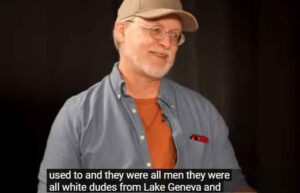This video on the origins of tabletop RPGs made the rounds last week because Jason Tondro, in the white beard, took a few minutes to beat his breast and put on a hair shirt and self-flagellate that the hobby grew out of a normal guy scene in the late 1960s and early 1970s. However, there’s something far more interesting buried at the 21:30 mark.
YUGE hat-tip to Bradford Walker, and an anonymous hot-tip reader of his for pointing this out to me.
At the 21ish-minute mark, Jason launches into a very interesting story about pre-GenCon tournament D&D play. What it looked like. What players did.
SPOILER ALERT: The #BROSR was right. About everything.
I’ve pulled the transcript and cleaned up the language a bit for readability’s sake. Via a herculean effort of self-control, I’ve also limited my editorial comments [set off in brackets] as well.
When D and D first came out people didn’t understand this game at all. What is it? How do I play it? What is a session of this game even like? And so Gary wrote a column in a European wargaming fanzine called Europa where he explained the game and gave an example of play – which the brown box does not have… Well, we have that column in Europa and we reproduce it completely and you can see Gary’s advice on how he thinks the game should be run. How it how it’s played. What it’s like. And in that article we get some really interesting insight into how the game was played in 1974. It’s very, very different than the game that we play today.
Gary opens up his advice to DMs by saying your players will start off working together. It won’t last, he says. Pretty quickly after they get out of the dungeon they’ll split up, and they’ll all want to go do their own things, and they’ll recruit followers, and they’ll want to take over the town, or they’ll want to start businesses, or they’ll want to find magic resources to boost their Wizard’s power, or whatever.Let them do this.Encourage them to do this. Let them all kind of become rivals in this Overland world map that you’ve created. And they’ll come together once in a while to go another level deeper into the dungeon, or to fight off some big arch enemy that you’ve created for your setting. But mostly they world build, or they’re empire building and fighting each other and conspiring [emphasis added]. Or maybe a couple of them get together and go off on an expedition, and then they come back.The whole way that we think of a D&D party as like these five or six adventurers that get together and go down into a dungeon and they stick together, and they have a whole adventuring career together and we never split the party. That whole notion was totally foreign to how the game was played in 1974.It’s amazing! It’s really, really interesting. And you can see why it was done this way when you look at the logistics of running the game. Because Dave and Gary both had like 16 players in their games, right? It’s a lot.
It even at one point the book [OD&D, presumably] says well you probably want to keep it to like 12 players . Ten players if you’re just brand new and starting, like if you’re a rookie DM, ten players that’s your limit, right?
So you have very large groups… and players were kind of playing the game every day. Like they would give Dave or give Gary things that they wanted their character to be doing basically all the time. It was a 24/7, constant thing…
…and as a referee, as a DM, you just can’t create enough content for 16 players playing 24/7 right? Like, who has the time to create dungeons and adventures for everybody in this world instead you have to be like Godzilla versus King Kong. You just lean back and watch them fight right, and instead you create like the mega dungeon, the big infinite levels Mega dungeon, that player characters cannot explore alone. They have to come together and then you create big threats like it’s an invasion of Barbarians from the North or something, right? And this becomes kind of your big story arc, but the real [!] game play is the individual actions taken by characters as they amass power and rival each other and try and steal magic items or resources from each other.
It’s a very, very different kind of game, but I think that the way that we play the game today is really born out of the tournament circuit. When you demonstrate D&D as Arneson did for Gygax in that fateful January 1973 session you don’t demonstrate the Empire Building part. You demonstrate the dungeon. That’s what captivated Gygaxin the first place, was the maze. The dungeon-like maze. And players would come to Gen Con and they’d play the Tomb of Horrors or the Lost Caverns of Tsojcanth or whatever, and that was their experience of D&D. A bunch of people getting together, and the groups were very large, a bunch of people getting together and going through the Tomb of Horrors and half of everybody dying.And that dungeon experience was the game, and you take that back to your players, and you run that game – and there were other things in these books about building your castles and hiring your soldiers and all that stuff – but it didn’t grab players the way that the dungeon delve did. So that’s what they experienced. That’s what they had fun with, and that’s what they played, and that’s ultimately what the game became.



Oh my goodness. Thank you for sharing this. I hadn’t seen this longer video, I just saw the shorter one where Tondro made fun of the “waRgAMerS”.
I took part in a conversation about this very subject on the *Clerics Wear Ringmail* discord last month.
I wrote a piece for my ‘stack about it and forgive me for quoting a little piece of it here:
“Let me repeat this for ADDED EMPHASIS, “long-time, veteran wargamers, with a thorough knowledge of the foundational principles of War Games, who were simply wild about playing map-based Campaign games”. This is the MOST IMPORTANT thing to consider when thinking about how the game of Dungeons & Dragons was originally conceived, and the atmosphere that existed in and around the initial sessions.”
Dungeons & Dragons is a war game, keep spreading the word brother!!
Never would have made it 20 minutes into this video without Bradford and his inside source.
There’s still more to unpack here. There is an admission that churning out tournament modules as examples of play played a big part in “forking” the game away from wargames and towards the monorail style epitomized by DragonLance modules.
They make the same mistake thinking that those 10-16 players were all running at once. Rather than a constant rotation as they caught the game at various times.
I agree that the module did fork out D&D into the form we largely know it today.
But it must be admitted: Gygax and TSR did it to themselves, and published no corrections when it became evident what people were doing by the letters sent to Dragon and strategic review.
In my opinion: Gygax was too busy off doing other stuff in the early 80’s, and also assumed people would have deduced his intended mode of play from the DMG – which they clearly did not. It is his post TSR games where it seems that he largely just threw in the towel and went along with conventional play.
Maybe he thought his early clubhouse play was irreplicable by the current hobbyists? We’ll never know.
That’s a fair point. If you include all the players that we’re cycling through different DMs’ campaigns, the total number was certainly higher than 10-16. Not all at one table, but all actively engaged with each other.